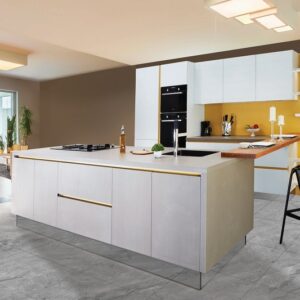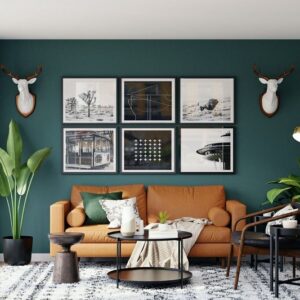Biophilic design is one of the biggest trends in the interior design world with many homeowners and interior designers looking to bring the outside indoors with their décor. Humanity has an innate connection with nature, so incorporating more natural elements into your home seems only natural. There are many elements that you can include in your home to embrace biophilic design, such as natural light, water and plants.
Health and wellbeing can be benefitted with biophilic design, as it’s proven to reduce stress, improve mood, boost productivity and increase focus levels. It will also improve the air quality of your home, which can be great for your physical health as the air you breathe in will be more purified. Eco-friendly practices are also enhanced with biophilic design with more natural materials being used that will reduce your carbon footprint.
This guide will explore indoor gardening and its health and well-being benefits, which have made it a huge hit in interior design. Continue reading for the best biophilic décor inspiration.
Biophilic Home Interior Design Ideas
1. Natural Light
Studies have shown that most people spend 90% of their time indoors, which severely limits natural light exposure. This means that we are more exposed to artificial lighting, which isn’t good for our health. It can disrupt our circadian rhythm, leading to worse sleep that can affect our cognitive function. Natural light helps us regulate our circadian rhythm and coordinate physical systems. This makes it vital that we increase the natural light exposure in our homes, especially since we spend so much time indoors.
There are several ways to get more natural daylight inside our homes. Installing more or larger windows in the home will allow significantly more light to shine through, which will make your home brighter and require you to use less artificial light. Strategically placing mirrors throughout your home can also boost natural light balance, as it will reflect off the mirrors to make a space gleam more.
2. Greenery
Greenery in the home is a fundamental core of biophilic décor. There are many health, wellbeing and eco-efficiency benefits to having an increased amount of greenery in your home, as it can reduce stress, improve sleep, boost productivity and reduce our carbon footprint. Plants are a great addition to any home with some of the best types being peace lilies, spider plants, snake plants and aloe vera.
Having living walls and indoor gardens are the most effective biophilic designs you can include in your home. Homeowners are sometimes concerned about the overgrowth of plants in the home, but they aren’t very difficult to manage as long as you have a trusty pair of pruners that will maintain your indoor garden with just a few snips. Faux plants can also have some of the same benefits as real plants and require less maintenance, so this could be a valid option.
3. Natural Materials
Sustainability is the focal point of biophilic interior design and one way to incorporate this is by using more natural materials in your home. It’s good for the environment if you use materials that have been naturally sourced, as opposed to using synthetic materials. It can make you feel more connected to nature, which can make you feel more positive about your home environment.
Natural wood, bamboo and stone are the most popular materials to use in the home, as they are all very versatile and can be used for a large variety of different pieces of furniture. Wooden furniture in particular is a renewable resource that can be replanted. It’s very durable and pleasing to the eye, making it perfect for use around the home. It can also be very effective for regulating humidity and holding heat, which is great for reducing your gas and electric usage.
4. Water Features
An underrated addition to any home is a water feature. You can add water features to your home in many ways, with the most popular being fountains and water walls. These can have many benefits to your home wellbeing, including improved air quality, reduced noise pollution and increased property value. The natural sounds of running water in your home can bring you to a calming state of serenity and create a peaceful environment for meditation and relaxation.
Small water fountains in your home can be significantly beneficial due to it releasing oxygen into the air. This can make the air in a room be more purified, which can lead to improved breathing that can positively impact your lung intake ability.
5. Multi-Sensory Experiences
Biophilic design isn’t just about creating a sustainable environment that reduces your carbon footprint, it’s also about manufacturing a space that works your senses to boost your serenity and make you feel more comfortable. Designing a biophilic space can engage multiple senses through natural fragrances, sounds of flowing water and textures that replicate natural surfaces that can be found outside.
You can use natural fragrances in your home by growing plants, using essential oils, making potpourri or using baking soda. Essential oil diffusers can be purchased in scents that mimic that of the outdoors. Alternatively, you can make your own air freshener by mixing a few drops of essential oils with water in a spray bottle. These natural scents that make your home smell fantastic and allow you to better embrace your environment.
6. Organic Patterns and Shapes
Another benefit of biophilic design is that it allows you to incorporate more organic patterns and shapes into your home décor. These can be inspired by natural elements, or be the natural elements themselves to create a calming and visually pleasing environment for you to relax in. A unique way to do this is by incorporating natural fabrics into your furniture and décor, such as cotton and linen. You should use organic shapes sparingly to avoid overwhelming the space. If everything is the same you run the risk of making the space feel unnatural which can ruin the aesthetic you’re trying to create.





